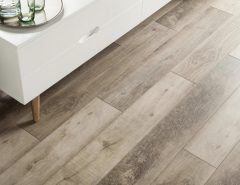 There are a number of reasons why tile can become damaged — something was dropped on the tile, the thin set was applied unevenly, or there is a hydrostatic pressure issue that is causing a lifting of the thin set from the surface it is adhered to.
There are a number of reasons why tile can become damaged — something was dropped on the tile, the thin set was applied unevenly, or there is a hydrostatic pressure issue that is causing a lifting of the thin set from the surface it is adhered to.
The type of damage to the tile will determine how to repair it. For the most part, this is a common sense type of project, and can be considered similar to fixing a cavity. Here are some scenarios for tile repairs:
1. Loose tile. If the tile feels like it is not attached the floor, is wobbling, or has a popping sound when you walk over it, then you will need to consider removing the tile, and replacing it, or if it can be lifted out, re-adhering the tile to the floor.
2. Cracked tile. If the tile is cracked, it can be removed in pieces quite easily, and then replaced. Cracked tiles can be a result of poor installation, damage or a flaw in the tile manufacturing.
3. Uneven tile that is chipping. The main cause of this is a direct result of an uneven layer of thin set during installation. This type of situation can cause injury, and create chipping on the edges of the raised portion of the tile.
For all of these scenarios, there is a quick fix that does not have to take a long time to correct. The best part about this type of project is that there is no detailed measuring that is necessary, rather you just have to make sure that you replace the tile with one that is the same size, color and pattern. If you do not have a ready supply of extra tiles, you may need to consider finding the closest possible match. There are lot of free samples and other freebies available that can make your project easier. Otherwise, follow these simple steps to remove and replace a damaged tile.
1. If the tile already has a crack, use it! Using a chisel and a hammer, place the chisel on the fissure line of the crack. Hammer it until the crack is defined and separated enough to begin getting under the tile. This will help protect the surrounding tiles. Another technique that you could use is to use the same chisel and hammer to begin to break down the surrounding grout. Grout is very brittle and can be destroyed without affecting surrounding flooring. This is the best technique if there is not crack present. Once the space is created, you can begin to pry off the damaged tile.
2. Preparing for setting. Once the old tile has been removed, you will need to prepare the floor for the new tile. This process is the same for installing a whole floor, as the surface needs to be cleaned and free of debris. Having old thin set on the floor can make for an uneven fix, and create issues later on with lifting thin set. Using a scraper, clear of all the old thin set. This might also require the use of a hammer to chip away the thin set.
3. Ready, set, tile! Once the area is cleaned and prepped, you can place the new thin set on the floor or surface. Do so using a trowel or, for a single tile, even a spatula would work. Place the tile on the new thin set, making sure to use a level to ensure a matching height. You want to make sure that the thin set is thick enough and spread evenly enough to grab the entire underside of the tile. Allow the thin set to dry approximately 24 hours before walking on the surface.
4. Fine finish! After the thin set has dried, you can now add the grout. Make sure you have color matched the grout with the existing grout. You can place the grout right over the spaces that are existing and there is no harm in placing grout over existing grout. Wait for the grout to dry, then use a sealant on the new area.



















